Market Validation – Workshop 1

Executive Summary Video
The Appleton Greene Corporate Training Program (CTP) for Market Validation is provided by Mr. Christie MBA BS Certified Learning Provider (CLP). Program Specifications: Monthly cost USD$2,500.00; Monthly Workshops 6 hours; Monthly Support 4 hours; Program Duration 24 months; Program orders subject to ongoing availability.
If you would like to view the Client Information Hub (CIH) for this program, please Click Here
Learning Provider Profile
Mr. Christie, MBA, BSc, is a Certified Learning Provider (CLP) at Appleton Greene. He has experience in marketing, management and human resources. He has achieved a Masters of Business Administration and a BSc in Wildlife Biology. He has industry experience within the following sectors: Life Sciences, Biotechnology, Healthcare, Technology and Telecommunications. His Program is available within the following countries: United States of America, Australia, Canada and the United Kingdom, or more specifically within the following cities: San Francisco CA, Boston MA, Melbourne AU, Toronto ON and London UK. His personal achievements include: Baxter Area Manager-of-the-Year for three consecutive years, doubling revenue in a flat market; restructured Medigas and reduced operating expenses by 25%; became Laidlaw’s third-ranked market in North America with 16.5% RONWA; reduced VSM Medtech manufacturing times from 18 months to eight; and quadrupled revenues while increasing profits 12-fold at Pyng Medical Corp. His service skills incorporate: go-to-market strategy, market validation, market assessment, technology commercialization and marketing strategy.
MOST Analysis
Mission Statement
The mission for the first module of the Market Validation Program (MVP) is to capture the essence of what MVP is all about, as succinctly stated in the following quote from the Program lead facilitator:
“Any business is far more likely to succeed when an idea, good business plan, and a business person are matched with consultants who have proven industry track records.”
Participants will learn about MVP’s history, current position and future outlook. By the end of our day together, they will appreciate why Market Validation matters and what it means to their business.
MVP favorably impacts an entire business and it especially adds value to sales, marketing and sales/marketing/customer support functions in each business.
The Program is process driven. In each session together, basic concepts are described, examples are provided, and exercises are described. All participants then get the opportunity to work the exercises, which become homework for final review and revision prior to delivery of the next monthly module.
Although sales and marketing is the core function that MVP addresses, our experience is that company’s gain the most value from the Program if their executive leadership team participates. In small company’s this includes the CEO, 2IC, Founders and any other key senior executives. With large corporations this may not include the CEO, but should include their delegate, and must include the most senior sales and marketing officer. Together, this team will travel the MVP journey toward increased revenue, at lower cost, with shorter sales cycles, and greater profitability.
This module ends when the participants acknowledge the MVP Mission, how it applies to their organization, and accept the following pre-work assignment for the next module:
PRE-DAY TWO – THEME: DEFINING THE BUSINESS OPPORTUNITY
12-page WORKBOOK – completion prior to the next module is mandatory
Review and complete all worksheets to complete the module. You should expect this to take six hours. Consistent with the Mission, this workbook includes a clear identification of you, your company, when the company was founded, how many employees and customers, what industry classification you are in, the back story or brief history of the current opportunity you are pursuing, your goals for participating in the program, the source of your innovation, the extent of market and technology innovation, a brief description of the customer problem you are solving, personas of the people who will use, support and buy your product, what a day in the life of your customer looks like, how this may change with use of your product, your market type and why, a succinct description of your product, your competitors, why your customers will buy your product, and the top three things they most like about your product. If any of these parameters are not yet known, you are expected to hypothesize as best as you are able to do so.
RECOMMENDED READINGS – participants may choose not to read these, or just read online summaries
• The Four Steps to the Epiphany by Steve Blank
• Crossing the Chasm by Geoffrey Moore
• Made to Stick: why some ideas survive and others die by Chip and Dan Heath
ADDITIONAL RESOURCES for START-UPS
If you wish, Google these videos:
• Why Accountants Don’t Run Start-Ups – Steven Blank
• Lean Startup Summary
ADDITIONAL RESOURCES: CUSTOMER DEVELOPMENT
• The Customer Development Methodology by Steve Blank (Chapter 2 of The Four Steps to the Epiphany)
Objectives
In part 1, delivered in month 1 as workshop module 1, our Corporate Program Objectives are to:
1. Introduce all program participants, including Appleton Greene personnel & company representatives
2. Review MVP content, principles, culture and process
3. Discuss learning goals for the day
4. Define “Market Validation”
5. Discuss the four core principles of the MVP
6. Review the three levels of Market Validation
7. Encourage company participants to shift their thinking out of their comfort zone
8. Capture some thought leader principles, including Paul Singh’s default state of a startup, Steve Blank’s definition of a startup, and Ralph Turfus’ thoughts on startups, where “startup” may include any new business initiative in a well-established business
9. Overview of all 24 MVP modules
10. Questions, discussion and active participation with in-class exercises
Strategies
1. Each participant should come to the first module with a clearly articulated three-minute summary of who they are, what role they fulfill in their organization, something interesting about them that others do not know, why they are attending MVP, and what they expect to get out of the Program.
2. The facilitator must be prepared to review the first seventeen slides in the MVP Power Point Deck, in a clear and compelling way that engages all participants. If we just wanted the facilitator to read the slides, then we would just circulate them in advance to all participants. We want the facilitator to animate the slides, with passion, conviction and clarity.
3. The learning goals for the day are to ensure participants understand the MVP Mission, the principal goal of which is to literally validate each business opportunity by acquiring customers and generating positive cash flow from those customers, sooner than later. MVP does not address how to raise money. We also want participants to understand the two prerequisite forms of validation – customer discovery and minimum viable product testing, which must happen before customer acquisition. It does not matter what stage of market validation each organization is at; the Program is designed to add value at any stage. We also establish the four principles of MVP, encourage participants to shift their thinking out of their comfort zone, and understand that novel business opportunities are different than business-as-usual sales processes.
4. To define Market Validation we have one seminal slide that does so eloquently. We expand on the content of this slide and then ask each participant to work through where they believe they are at on the Market Validation continuum.
5. Again, there is a slide dedicated to describing the four core principles of MVP: it’s a framework not a formula, it focuses on those few things that deliver the most results (the 80:20 rule), these few things need to become best practices, and working with your consultant/mentor, we intend to make these best practices live for you, becoming part of the culture, rhythm and discipline of your business. In other words, it comes down to “Learning by Doing”.
6. The review of the three levels of market validation expands on strategy #4.
7. The facilitator reviews the one slide that asks participants to shift out of their comfort zone and then invites each participant to describe what this may look like for them, using the Socratic method.
8. Six slides challenge people’s perceptions to help them open up and see how their opportunity may be at risk of failure, hopefully sooner than later, or may be positioned for success, if they embrace and learn from the Market
Validation Program.
9. We provide an overview of the 24 MVP modules, using the Unique Program Proposition and the Client Information Hub.
10. The day ends with an open forum for Q&A, discussion, debate and most importantly, feedback from each company participant and consultant on what they most liked about the day. These comments are captured for sharing prior to the next module. Everyone is then asked to complete a Workshop assessment form, which is reviewed by Appleton Greene personnel with a goal of continuous program improvement.
Tasks
1. The participants must come to the module prepared, and the AGC consultant must ensure that they are. The Program administrator must ensure that the pre-work materials are circulated at least four weeks in advance, and that they have received confirmation that these materials have been received and understood and that each participant commits to giving them due thought and consideration.
2. The facilitator must be thoroughly prepared and this requires review of the materials, understanding them, and practicing their delivery repeatedly, until they can virtually do it in their sleep (something that I have had to do when we flew from the west coast to the east coast and started the sessions next day at 4:30 am body time).
3. The learning goals for the day are relatively modest compared to some of the subsequent days, which allows for the participants and consultants to get to know each other, the administrator(s) to work out any technical or logistical kinks, and the entire group to ensure alignment between the Program objectives and individual objectives.
4. The facilitator needs to really understand the Market Validation concept and how to articulate this.
5. The four core principles should be relatively straightforward, but the facilitator may wish to explain them to their children to ensure they can understand them, assuming that they are at seventh grade or higher.
6. Back to point #4, we cannot emphasize enough how important this is.
7. Shifting everyone out of their comfort zone is a two-way street: the facilitator needs to motivate everyone that this is a great thing to do and the participants need to really want to do it. Ask the question: How many psychologists does it take to change a light bulb? Just one, but the light bulb really has to want to change. The same is true for the participants, regardless of how compelling the facilitator may be. They need to concede that their current approach in the market may be improved upon.
8. These six slides draw off a broad and deep knowledge of a few very talented authors. The AGC facilitator needs to look at these books and at least read the summaries, which they should then discuss with their CLP, to ensure they understand the concepts and how best to speak to them. For example, “customer traction is the new intellectual property” according to Paul Singh from 500 Startups. Well, what does that really mean and who gets this at first pass. When you think about it, it makes sense, since customers pay your bills, validate your value propositions, and create distance between you and your competitors. Customers probably could care less if you have an issued patent, as long as your solution solves their problem and enhances their business.
9. The 24-module overview should be fairly straightforward, provided the facilitator is up to speed.
10. This end of day strategy happens quite spontaneously, provided that the day has been well facilitated and the participants have become engaged in the process. It’s all about preparation.
Introduction
Planning
Appleton Greene and their clients who wish to participate in the Market Validation Program, need to all understand that “participate” is the operative word, this is not a Program that one just attends. Therefore, the AG consultants and contracted clients must plan to properly prepare for and participate in the first module, and all modules that follow each month until the Program is completed in 24 months. This incorporates the following considerations:
1. Scheduling – if it is not in your calendar, then you cannot plan to attend. The class sessions will be locked down, four weeks apart over the two-year period. The preparation time, which at least equals the class time, also needs to be scheduled, at the discretion of each individual participant.
2. Pre-work – there is a clearly defined package of pre-work for each module, although the first module is light on this, since the main requirement for Day One is that:
“Each participant should come to the first module with a clearly articulated three-minute summary of who they are, what role they fulfill in their organization, something interesting about them that others do not know, why they are attending MVP, and what they expect to get out of the Program.”
The participants must come to the module prepared, and the AGC consultant must ensure that they are. The Program administrator must ensure that the pre-work materials are circulated at least four weeks in advance, and that they have received confirmation that these materials have been received and understood and that each participant commits to giving them due thought and consideration.”
For example, by way of introduction:
“My name is Mr. Christie. I am an experienced life sciences start-up executive who’s worked with hundreds of companies over the past decade, at least 60 of them quite intimately. I am also the Appleton Greene Certified Learning Provider who is making this Market Validation Program available to all of you. You likely will not meet another person who has sold heart valves and managed a garbage hauling operation, but that’s me, and this is just part of my successful and eclectic career over the past 40+ years. My interest in the Market Validation Program runs deep and wide, with experience initially as a mentor, and then as the chief facilitator over many years, delivering it to companies of many different sizes, at various stages of market readiness, from coast to coast for various different organizations, including start-up accelerators, universities and government agencies. What I have learned is that there is much to learn each time from the Program participants, who constantly enlighten me and provide me new things to ponder. Finally, I have learned that for each hour I spend in class, I spend many hours preparing, reviewing, debriefing, and updating the materials based on customer feedback. Welcome and enjoy!”
3. Post-work: just as the pre-work and attendance at each and every workshop, is crucial, so is the post-work, which in many instances is mostly focused on reviewing the exercises drafted in-class and up-revving them in to the final working draft. This is a discipline that must be developed, calendarized and followed-up by the AG consultant and by the responsible person in each client organization. If they don’t do the post-work in a timely and dedicated manner, then they are missing out on much of the value in the Program.
4. Go-to-Market Planning: the compilation of all 24 sets of pre-work, in-class exercises, and post-work, when polished up and finalized, constitutes the core deliverable from the Program – the Go-to-Market Plan. We provide a sample copy of this, circulated around the room, on day one for everyone to see. The go-to-market plan is what the AG consultant must ask for whenever they meet with their client participants to review progress in the Program.
5. Workshop Materials: as the Program CLP, I have ownership for the Master Slide Deck used in the program, and it is big, with talking notes, examples and clearly articulated core concepts – approximately one concept for each module on average for a total of 24. These 24 modules are described in overview during the first workshop. The Program Deck has been revised countless number of times and is always a work-in-progress, since one of the core values for the Program is continuous improvement.
Having addressed the mechanics of operational planning for the Market Validation Program, let’s look at strategic planning from the perspective of the participating companies. To qualify for the Program, each company and each participant must have a legitimate interest in learning new concepts, applying them to their department or company, and recognizing business outcomes not otherwise attainable. For example, when start-ups participate, they are most often desperate to learn how to realize revenue, now that they have developed and tested their prototype, product or minimum viable product. They do not know what they do not know, but they do know that once they stop developing and begin marketing, they need serious help, which the AG consultants and the Market Validation Program can provide.
A useful planning framework for an AG consultant to use when working with their clients to determine the interest and applicability of the Program to them, their department and their company, is to review Steve Blank’s Customer Development Model, as described succinctly in the first few pages of Chapter Two in The Four Steps to the Epiphany. In his introduction to this chapter, Steve describes the plight of Rob Fordes, Founder and CEO of Design Within Reach, who spent his time listening to customers. However, at the time when furniture dot-coms were “rolling in investor money” the venture capitalists Steve introduced Rob to were simply not interested, because Design Within Reach did not yet have a web site, e-commerce transactions, significant branding activities or other turn of the millennium activities.
Rob’s Company was not your typical dot-com startup, who “operated on the James Dean School of Management – live fast and die young…they garnered millions of dollars of investors’ capital quickly and just as quickly flamed out.” For example, Furniture.com raised over $100 million from first-tier VCs but ultimately failed. Steve asks his readers the question: why did Design Within Reach ultimately succeed, despite the lack of VC interest, while the Furniture.coms of the world became dot-bombs? As a Stanford business professor and successful serial entrepreneur, he wanted to know if others can emulate Rob Fordes’ success.
Enter the foundation of The Four Steps to the Epiphany and The Customer Development Model. The Model provides a repeatable tool that can be applied to any business, in any industry, at any stage of revenue generation. It provides a process for discovering markets, locating first customers, validating go-to-market assumptions and growing the business. It solves the 10 problems inherent in the Product Development Model (described by the author in Chapter 1 of his book). The Model’s strengths are rooted in its rigor and flexibility.
“The model separates out all the customer-related activities in the early stage of a company into their own processes, designed as four easy-to-understand steps: Customer Discovery, Customer Validation, Customer Creation and Company Building.” This process-driven model supports the complimentary Product Development Model and provides the tools for companies to launch new products, or in the case of startups – entire companies, in a way that accelerates time to market, de-risks the venture, and increases the likelihood of success, as defined by profitable early revenues. Each of the four steps in the model has its own clearly defined deliverables, described by the author in subsequent chapters. We reference Steve Blank during the day in Workshop One, repeatedly throughout the Program, and provide a comprehensive overview of the Model and how to apply it.
In planning to get the highest return on investment, on the $60,000, plus the investment of time by up to ten highly-paid marketing executives, it is also useful to look at the Service the Program originally modeled itself to emulate: MIT’s Venture Mentoring Service. In the early days of the Program, two of the principals travelled to Boston and attended a week-long seminar designed for people like them. The MIT Founders were famously quoted regarding the essence of their service:
“A fledgling business is far more likely to succeed when an idea, a good business plan, and an entrepreneur are matched with mentors who have proven experience.”
What we have learned from years of delivering the Market Validation Program, is that a fledgling business may also be a fledgling opportunity – such as taking an established product and introducing it in to a brand new and different market. For example, a family-owned and operated ten-million dollar a year in revenue, company on the Canadian prairies wanting to enter the US mid-west. Through the course of the Program, they realized that this opportunity was bigger than they were and that their best opportunity to grow was to double-down on their domestic markets, where they may one day dominate. Further, an idea is not just those of start-ups, it could be any opportunity in an established company. Most corporations today recognize that to successfully launch a truly new and different product, they must take an entrepreneurial approach and sidestep their own bureaucracy. A good business plan is the major deliverable from the Program, packaged as their Go-to-Market Plan. Mentorship is provided by the AG consultants and the Certified Learning Provider.
In planning for the MVP journey, participants are invited to step back from day to day sales and marketing operations and consider such concepts as market type, levels of innovation, positioning, value chains, value propositions, return on investment, minimum viable product, market segmentation, market or opportunity size, technology adoption life cycle curve, customer discovery, selling, the sales funnel, corporate pitch, business model canvas, 6-month plans, 1-page plan, the go-to-market plan and half-a-dozen other concepts over the two-year Program period. This should make them feel uncomfortable, because we ask them to step out of their current paradigm and take a fresh look.
Authors such as Steve Blank are referenced, as is Paul Singh from 500 Startups, Ralph Turfus – creator of the original Market Validation Program, and others – including Bill Gates. For the AG consultants, CLP(s) and client participants, our mutual goal is “you, acquiring customers”. In other words, customer acquisition is the modus operandi of the Program. It’s not about financing through investors. It is about generating a cash-flow positive business model by acquiring customers quickly, cheaply, profitability and in a way that fits with the corporate culture. We like to say, this Program is all about how to make money the good old-fashioned way – by meeting the unmet needs of your customers and getting them to fall in love with you so they will never want to leave or even look at dating your competitors.
A few words from Simon Fraser Universities’ iiDevLab biography of the Program founder:
“Ralph Turfus – Investor, Mentor and Chair of Redlen Technologies Ralph Turfus is an accomplished technology entrepreneur who has spent over four decades in the Information and Communication Technology (ICT) sector. He founded Escom Software and during the following 28 years launched 8 start-ups, all self-funded. One such start-up was Class Software which became the leading provider in the world of software for municipal government recreation programs.
As an engineer with an MBA, Ralph’s passion is for developing the marketing and sales capabilities of entrepreneurial technologists. He is a highly-regarded speaker on the topic and is a hands-on angel investor and mentor who is active with the founders of numerous next-generation technology companies emerging on Canada’s west coast. Ralph has invested in twenty-four technology start-ups and eight venture capital funds. He is currently the Chair of the Board of Redlen Technologies and Navarik Software.
Ralph and his wife are currently funding a Chair at the University of Victoria for Dr. Chris Darimont of the Raincoast Applied Science Conservation Lab. They have been involved in successfully stopping the bear hunt in the Great Bear Rainforest and the province as a whole. They are now focusing on developing an Evidence Based Management (EBM) structure and agreements to optimally manage First Nations resources. They are also funding and helping to manage an initiative called Advancing Innovation in Medicine (AIM) at the Royal Columbian Hospital in partnership with the Royal Columbian Hospital Foundation. AIM’s purpose is to (i) enhance patient outcomes, (ii) increase hospital productivity and (iii) advance a culture of innovation leading to retention and acquisition of the best and brightest talent at the hospital.
RECOGNITIONS:
2000 – Canadian Recreation Association Person of the Year
2006 – B.C. Technology Industry Association Person of the Year
2009 – AceTech Fellow – Growth Strategy Program (aka Market Validation Program) – founded and ran it for five years
2013 – Queen’s Diamond Jubilee Medal – for Technology Industry contributions
2015 – BC Angel Investor of the Year”
The Turfus quote we most appreciate and share with all Program participants, ends with this:
“_____________________________________________ cures all business ills, so get to that state as fast as possible.”
The quote begins with: “Profitable, repeatable and increasing revenue”
Put it all together:
“Profitable, repeatable and increasing revenue cures all business ills, so get to that state as fast as possible.”
Ralph Turfus, Creator of the Growth Strategy Program (later renamed the Market Validation Program). As you can see, Ralph practices what he preaches and we invite AG consultants and Program participants to do the same.
Development
The foundational development model for the market validation program is implied by its name – we ask participants to make hypotheses that they can then validate or not. This continuous process of improvement leads us to customer discovery, minimum viable product testing and ultimately, new revenue generation. These are the three levels of market validation. By going through this process, the company participants develop a project with a clear end point – a profitable company or division. The aim in the development phase is to ensure understanding of all the core concepts, the challenges of addressing the core business differently and the opportunity to use Program concepts to accelerate revenue growth, thereby de-risking the business and getting to profitability faster.
The most advanced concept in this development model is the business model canvas, which we do not address directly until late in the 2-year Program. We do however push the participants during day 1 to think about why they are attending and what they expect to get out of the Program. Their participation is based on a set of assumptions, or hypotheses, that will be tested over the following 23 workshops. They will get their first taste of this during day 1, when mentors, participants, CLPs and others will begin asking questions that may initially make them squirm. Consider the following from Osterwalder and Pigneur’s seminal work on Business Model Generation:
“When you are working on a new business idea, you may be confident that you are on the right path. However, each building block of your business model and value proposition represents an area of risk that needs to be tested: customer segments, customer relationships, key resources, key partners, key activities, channels, value propositions, revenues and costs. In order to run good experiments to test our business ideas we need to formulate strong hypotheses that are testable, precise and discrete.
Before you start testing your idea you have to identify the risks within each building block of your business model and value proposition by formulating hypotheses. We define hypotheses as:
• An assumption that your value proposition, business model, or strategy builds on
• All the things that would have to be true for your business idea to work
At the core of identifying hypotheses, you have to ask yourself the question: What would have to be true for our idea to work? You capture each hypothesis by writing phrases that begin with “we believe that…”
For example, we believe that active engagement in the Appleton Greene Market Validation Program will build stronger business leaders, who engage in the MVP processes and principles, thereby improving key business outcomes, including but not limited to: increased revenue, decreased cost of sales, increased gross margins, lower risks, faster time to market, shorter sales cycles, and overall greater profitability. During its first two years of rollout we will test these hypotheses, through a combination of customer discovery, minimum viable product testing, and revenue-generating customer sales, including proper post-sale follow-up to measure value actually delivered.
In product development, including software development, or in customer development, we follow a waterfall model, whereby we clearly state what the design input requirements are, by developing a suite of services that directly addresses these requirements, and then by testing each requirement against the designed solution for that requirement. Although there may be many shades of grey in terms of key success factors and how they are measured, the end-points are actually pretty binary. We either succeeded or failed to meet the customer requirement. At Baxter Corp in the eighties, where I worked as an Area Manager, our quality policy was simply: “To meet our customer’s requirements 100% of the time.” This sounds simple but in practice it was a huge leadership challenge. In our factories, we implemented various processes and standard operating protocols to ensure that it was virtually impossible to ever produce an undetected bag of intravenous solution, to a six-sigma test of 99.99966%. In sales and marketing, we worked exhaustively to ensure that we truly deeply thoroughly understood our customer requirements and then wrote contracts to exactly that level, no more and no less.
In a start-up situation, whether newco or newdiv, the threshold may be lower, as it usually is for minimum viable product (MVP) testing. For example, the MVP of a medical device is typically about 95% of the finished commercial FDA-cleared product. It is usually referred to as the beta prototype and must be produced in order to accumulate clinical validation data, under strict Ethic Board standards, in compliance with the Helsinki declaration. This is true even on low risk devices, if the regulatory agency requires clinical data. If not and the product may be cleared with only bench and/or animal data, then the beta prototype may be more elemental, perhaps at 90% completion relative to the final product. In consumer products, this threshold may be 80% or even as low as 50% or so, as is the case with some online products, which are intentionally launched in a very minimally viable format, to get early data without great expenditure. However, in any industry, once this MVP is tested and the market is validated, the finished product needs to appeal to a broader audience, not just the relative low bar set by early adopters, who accept incomplete products, because they want to be involved in the product development process. For example, with a medical device, the principal investigator is often a key opinion leader who wishes to publish, enhance their professional reputation, help to get a new and innovative product to market, and see the quality of patient care steadily and perhaps dramatically, improve, which everybody benefits from.
Whether a company participates in the market validation program from a perspective that this is integral to their continuous improvement in sales, marketing and customer acquisition, or because they see the 24-weeks as a sort of project to help them through a challenging market situation, the Program delivers accordingly. In the first module, everyone should get clarity about why they are attending and what they should expect. They should expect to have their fears addressed and questions answered. They should finish the day eager to proceed. If not, they should have the opportunity to leave the program, subject to AG policies regarding this.
To quote Dr. Jeffrey Liker, a University of Michigan professor, from his 2004 book, The Toyota Way:
“In his book Liker calls the Toyota Way “a system designed to provide the tools for people to continually improve their work.” According to Liker, the 14 principles of The Toyota Way are organized in four sections: (1) long-term philosophy, (2) the right process will produce the right results, (3) add value to the organization by developing your people, and (4) continuously solving root problems drives organizational learning.”
We love this quote and believe it applies to the Market Validation Program principles, which stress that you can never assume anything but that you most assume something and then test it to validate or modify accordingly. Or to put this more succinctly, in the words of W. Edwards Deming, considered by many to be the father of modern total quality management: “Blame the process, not the people.”
The process of development in the Market Validation Program begins with the first workshop, works up to the one-page (strategic) plan and concludes with the core Program deliverable, the Go-to-Market Plan. What emerges through this process is that some of the participants are leaders, some have the capacity to become leaders and some are not leaders, period. McKinsey and Company have studied leadership extensively, including interviews with over 500 CEOS and they conclude that only about 11% of companies are well led. In summarizing what needs to happen to enhance leadership development, they graphically illustrate the following key points:
• There is no silver bullet to improve leadership
• 40 key actions are required to increase the chances of success to 80%
• 20 key actions result in just a 30% chance of success
• 50 key actions result in a 99% chance of success
“That said, statistically speaking, four sets of interventions appear to matter most: contextualizing the program based on the organization’s position and strategy, ensuring sufficient reach across the organization, designing the program for the transfer of learning, and using system reinforcement to lock in change. This is the first time we have amassed systematic data on the interventions that seem to drive effective leadership-development programs. Interestingly, the priorities identified by our research are to a large extent mirror images of the most common mistakes that businesses make when trying to improve the capabilities of their managers. Collectively, they also help emphasize the central role of technology today in necessitating and enabling strong leadership development.”
Although the Market Validation Program does not explicitly claim to develop organizational leadership capability, our experience is that it does, as exemplified by the fact that we address all four program requirements mentioned above by McKinsey: 1) the Program is contextualized based on the participant’s position and strategy; 2) by involving ten participants from one company, we should ensure sufficient reach across each organization; 3) the Program was designed, and is constantly enhanced, to ensure the transfer of learning; and 4) we utilize system reinforcement to lock in change. Many Program participants tell us that the Market Validation Program was the single most transformative event in the history of their company!
In summary, the Market Validation Program development in the first workshop introduces all the key concepts that have made the Program such a huge success. It promises to increase sales while reducing costs, thereby improving gross margins and net profits. It reduces risk, accelerates growth and delivers revenues that were not available to participants and their companies prior to participating in the Program. It promises all of this and delivers more, including leadership development – in sales, marketing, and business management.
To quote a famous but unnamed source:
“Taka my seminar. It’s a goin’ to be really good for you. Good for you, good for your customers, good for everyone. So, donna’ delay, taka my seminar.”
Or if you prefer, please seriously consider participating in the Market Validation Program. It will make you a better sales and marketing manager and a better business leader. Those close to you will be grateful. If you have any questions, take them up with your AG consultant or contact me directly.
Implementation
Implementation is all about putting the plan in to action, which is exactly what Program participants are asked to do in the four-week interval between each workshop. They are further guided in this process by the exercises that they complete in first-draft form in each workshop, in second draft during the four- week interval, and in third draft in preparation for the next workshop. By the end of the 24 weeks, they will produce at least a fourth draft in the form of their Go-to-Market Plan.
Let’s look at an example. Jane Smith comes to the first module with the following introduction:
“Heh everyone, my name is Jane Bitealot, and I am Vice President of Sales at MegaDont. Something that people don’t know about me is that I am a collector of dinosaur models, so really how could I work anywhere else? My main interest in attending this Market Validation Program is to validate my assumption that Marketing has their collective head sunk very deep in to the proverbial hole. I hope and trust that what they learn from this Program will help them solve this problem, so that my sales people will be freed to unleash their true selling potential, before another meteor hits the earth.”
In coaching Jane, we may gently nudge her to replace the word “attending” with the word “participating” and why this difference is so fundamental to the likely success of MegaDont’s investment of time and human resources in the Program. We may also want to nudge her gently in private to rethink what she and her department can get out of the Program, and leave it to the VP Marketing to get the return on his time investment for his department.
We had a priceless comment from one attendee at the end of the last day of the Program:
“If only I had known at the start of the Program how much I’d get out of it by the end of the Program, I would have invested so much more time and energy during the Program.”
This same person went on to appear on CBC’s Dragon’s Den, where they were not funded, and ultimately, his start-up folded. Thankfully, this happened sooner than later, supporting the notion that the next best thing to quick success is fast failure. Perhaps if he had taken the Market Validation Program more seriously, he would have had a better business outcome, as the vast majority of participants will attest to.
To sum up by way of introduction, the key steps in the Program implementation process are:
1. Each participant actively engages in the pre-work, the in-class slide overview, and the post-work to ensure they understand each core concept covered in each workshop.
2. Then, with this conceptual understanding, each participant can turn their mind to the exercise that takes that core concept and encourages them to apply it to their business opportunity.
3. This first draft of the exercise is then reviewed with the peers and mentor at each table or breakout room or Zoom location – whichever is applicable in the current pandemic circumstance.
4. Participants then take their exercises back to their workplace and complete an up-revved version that they polish up and finalize prior to the next workshop.
5. As the workshops continue to unfold, the compilation of these exercises becomes the working draft of their Go-to-Market Plan.
Implementation is also about bringing the plan, whether it is an operating or business plan, strategic plan, one-year or five-year plan, one-page plan or go-to-market plan, to life. We encourage this by inviting all Program participants to, in the words of Steve Blank, get out of the building and talk to customers or prospective customers. Only then will they find out if they are on the road to redemption. As Blank puts it, there are most likely some epiphanies to be had along the way.
Contrast this to what one of our medical device founders told us:
“Oh, we would not want to talk to our prospective customers about this, because that may prove my brilliant invention wrong and then where would we be when we need to pitch to investors?”
He does get points for honesty and this unfortunately speaks loudly to the Founder’s Dilemma: too much invested in their invention and product development, with not enough invested in marketing and customer development. To quote Paul Singh, “customer traction is the new intellectual property.” Perhaps not surprisingly in retrospect, this same founder also refused to accept that his innovative design would not be accepted by the clinical community we were targeting, who stated unequivocally in many customer discovery interviews, “it’s great if it can do that, but it also has to look, feel and perform just like our current devices.” The three-part test for patentability is that it must be novel, not obvious to those skilled in the art, and be of commercial utility. This unfortunate situation illustrated a clear lack of commercial utility, which is not to say that the USPTO would not issue a patent, it just would not be worth the paper it was printed on, because clinicians would refuse to use it. Fortunately, through the customer discovery process, we found a doctor who proved out the alpha prototype on animal models, and convinced the founder that the novelty of the design would result in refusal to use it clinically. The design was modified, which ultimately strengthened the company’s intellectual property portfolio and the beta prototype is now in clinical testing for pending clearance by various regulatory authorities.
Although we only touch on this in the first workshop, by the middle of the Program, we speak extensively about how to implement the Go-to-Market Plan in a sustainable, repeatable way. This is the only way to create a revenue fly-wheel that will result in a virtuous upward spiral that leverages cash-in to a high return. In other words, without MVP $1 received may only realize $0.05 on their bottom-line net profit. But with more a properly developed Go-to-Market Plan, with well developed hypotheses well thought out and thoroughly tested in the market place, they may be able to triple this to $0.15. this difference between 5% and 15% profitability is dramatic and may be achieved by rigorously pursuing the core concepts of business modeling, whereby each of the nine business model building blocks is reviewed, tested and enhanced. Through such a process, the sales price may be raised, while the cost of goods and the cost of sales is reduced, thereby increasing gross margins. At the same time, operating expenses may be reduced, thereby improving net profits. This is a simple concept known as “positive drop-through”. It is one of many skills that can be developed in the Market Validation Program, and implemented in the participants’ company, during the business modeling workshops later in the Program. Business modeling is mentioned and briefly introduced in this first workshop.
“Implementation strategy is the process of defining how to bring the strategic plan to life. To execute the objectives outlined in the strategic plan, you must define how you will implement each aspect, from funding and personnel to organization and deliverables.” From Smartsheet, Dec 14, 2017. This is one of many templates found on the Internet. We use Vern Harnish’s One-Page Plan, also known as OPP, or sometimes, One-Page Strategic Plan, which is actually what it is. My companies find the OPP to be invaluable in the implementation of their plans.
Effective implementation of Program concepts is predicated on these three principles:
1. The active engagement of all participants – anyone not engaged slows the whole group down
2. Inspired leadership by the group facilitator – must be well read, well prepared and well spoken
3. Meritorious mentorship by all the AG consultants – engaged, inspired, passionate and focused
On the third and final point, all participating AG consultants will be provided with a 39-slide overview that outlines their obligations, the course material in a very condensed form, and how to excel as a Program mentor. Our intention is to share this with all AG mentors well in advance of the first workshop, so that they can opt out if they are unable to commit the time, energy and passion to be effective. Ideally, an all-hands AGC Zoom meeting one month prior to the first workshop should be conducted, the 39 slides reviewed and everyone participates in a question and answer discussion.
Please note that the MIT and Acetech models called for two to three mentors per company, which we understand may not be possible in the AG learning format. This is something open for discussion.
To better understand the time commitment required, recall that participants are told to expect to spend at least as much time outside the classroom as they do within. This equals 6+ hours over four weeks, or about 1.5-2.0 hours a week. Not unreasonable, but it needs to be in their calendar. The time commitment for mentors is comparable, but may be more than that for first-timers. My experience was that I spent a lot more time to read the relevant authors, think things through and put them in to the context of the Program materials. Honestly, I struggled with many of the exercises and had little patience for participants who could not do the simple arithmetic to estimate the size of their opportunity. I mean really: $x/unit X y# of units = $Z market or opportunity size, this is not rocket science, but for someone fresh out of industrial design school with no arithmetic aptitude, this is daunting.
For facilitators, the preparation time is much more significant. The Instructors’ Guide is a 51-page PDF document. One of our close colleagues and fellow facilitators estimates it has taken him on average 2 – 4 hours of preparation time for each of presenting time, so now we are talking about 12 – 24 hours over a four-week period. If the professional has some experience with some of the concepts, then this may be reduced, but the inverse is also true – if you are unfamiliar with the material, then you have to go to school on it until you are competent to teach it.
Finally, for effective implementation, which is really the translation of the classroom concepts, examples and exercises in to bringing these to life in the workplace, the material must be kept at about a seventh-grade level. This is not an academic program. It is a practical program. It also has to have broad universal appeal, so that a seventh-grader with English as a second language, can tackle the concepts and win. This is not about making anybody feel or look stupid. We have some very bright people who get stuck and need all the help that the mentor, facilitator and Certified Learning Provider can deliver.
As we now know, implementation is the actual day-to-day execution of the plan, in this case the Go-to-Market Plan. After each workshop, participants will need to work on implementation of the current workshop concepts, culminating in Vern Harnish’s One Page Plan, which distills the Go-to-Market, strategic and operating plans in to one single actionable page. My clients find this an invaluable tool and we expect that Appleton Greene Market Validation Program participants will also find OPP invaluable. We believe that our track record suggests that this will be the case, since average overall participant scores for the Program, when well implemented, are upwards of 90% (see VIATEC testimonial).
Management
George R. Terry, defines management as a process ”consisting of planning, organizing, actuating and controlling, performed to determine and accomplish the objectives by the use of people and resources.” Firstly, it considers management as a “process” i.e. a systematic way of doing things.
Said more eloquently, management is the art of getting things done through other people. When I first moved out of a sales executive role and in to a sales management role, our Vice President said to me: “this is a big step for anyone, because for the first time you will be responsible for a team of people and not just yourself.” Suddenly I had ten direct reports, a $20 million revenue responsibility and a million- dollar payroll. Fortunately, I also had a supportive general manager, two experienced sales manager peers and a great national marketing manager. We made things happen in my area and won the Area Manager of the Year Award three years out of five, while doubling profitable revenue in a flat market. I didn’t know it then, but we managed through by living many of the Market Validation Program principles – listen to your customers, test new products, practice continuous improvement, plan your work and work your plan, to name just a few.
Like many of us in management and leadership roles over the decades, I have learned that my knowledge and skill as a manager is a work-in-progress. My management style is not that of my clients or Program participants. In start-ups, they may not yet have developed any management style at all. But their organization, their investors, and all their stakeholders, cry out for them to not only manage but to lead their companies. We indirectly teach this in the Program, and by the end, they have a Plan, tools with which to implement and manage, and much more knowledge than they had at the beginning. They also have learned the common language that speaks to validate new products in the market, acquiring customers and generating profitable revenue.
In the opening workshop, we deliver a fundamental management challenge to all participants, who are you, what is your role in your organization, why should we care and what do you expect to get out of this Program. If they come across as selfish, short-sighted, inwardly focused or otherwise lacking in basic management skills, then we – the mentors, facilitator and CLP – know we have our work cut out for us. This individual will either leave the Program prematurely, and perhaps their company too, or leave it different than they came in, and we argue this difference will be for the better.
Marketing management is the business we are in throughout the Program, and this includes all aspects of marketing, from lead generation to lead qualifying to sales process and client development, managing the funnel, following up to ensure customer satisfaction, estimating market size, product positioning and so many more concepts that are developed throughout the 24-module workshop. An overview is provided of all 24 modules in the first workshop and participants are invited to comment and question. We hope they will come to the day with an open mind and leave with an expanded open mind. We want them to say WOW am I ever glad my Company signed me up for this, it’s going to make me more successful and it is going to do this with each monthly module I attend. I will manage better. When any of us attends a seminar, a talk, a workshop or whatever with speakers, exercises, pre-work and home work, we want to be inspired. It should be an experiential event that at least in some small way changes the course of our lives or at a minimum, our careers. I have been fortunate to participate in many management training programs, all of which contributed to my development as a manager, as a manager of managers, and as someone who can coach managers at all levels at any stage company in any industry. The Market Validation Program provides a wonderful environment for us to do so.
In the Executive-in-Residence Position Description’s Ideal Candidate Profile, they state:
“A collaborative and flexible management style with demonstrable experience in goal setting, team building and program/project planning.”
This compliments what is expected in the Market Validation Program. To let go of how you have done things and be flexible about adopting a new, different and proven-to-be-better approach; to collaborate with others in the Program, learn from them and impart learning upon them; help participants in goal setting and team building – which the Program itself is for all participants from the same Company; and finally Program planning – applying good planning principles to the Market Validation Program and delivering over the 24 weeks a comprehensive first draft of the Go-to-Market Plan.
In one of my favourite slides, we challenge everyone’s perception on the evolution of sales, from a sales superstar performance foundation in the nineties to the marketing management driven trends of today. The current trajectory suggests that sales and marketing tools, systems and methodologies will be virtually 100% of what makes revenues happen in just the next few years, perhaps hastened by the pandemic pivot most companies have had to make. This means that marketing management knowledge, skills and experience will rule the day and those that are stuck in past sales paradigms will rue the day they said no to a comprehensive and effective digital marketing strategy. These are the new maxims of business: get out of the building and connect with prospective customers, create awesome online content and continuously canvas your customers to discover their unmet needs, compile vast volumes of data on absolutely anything and everything to do with your marketplace – even if you do not yet know why this may matter, and continuously innovate to leverage social media, email campaigns and countless other 21st century tools that will be key to your future survival. This new reality is here and it will change before we can even get fully up to speed on what it means to our business. So, hire young, talented people, who you can manage, empower them, and help them thrive in the new revenue producing opportunity you provide to them. And take the Market Validation Program so you can apply the concepts and principles to help make all of this happen.
The core management principle that will be driven in the first workshop is self-management. Participants are expected to use their time management skill, self-discipline, and self-improvement to ensure that they allocate the time, energy and appropriate attitude to get the most out of the Program. It does not matter who is attending – Founders, CEOs and COOs, retirees, high school students, university graduates, post-docs, junior or senior consultants, or experienced corporate educators – all of us are created equal when we enter the Program class room. Everyone is asked to sign a confidentiality agreement, so that what is said in the room stays in the room, and protects the documented Go-to-Market Plans from unauthorized distribution. We also occasionally bring in subject matter experts in specific areas, such as medical device regulatory authorities, who are also expected to manage these confidentiality obligations. Despite these management constraints, the goal is to create a relaxed fun learning environment where everyone is at ease, communicates freely and prospers.
During the first workshop, in the latter part of the day when the facilitator is reviewing the last few modules of the Program, he or she will speak briefly about the Business Model Canvas (BMC). The authors of BMC, Osterwalder and Pigneur, offer a full week course on the Canvas, and we are only able to give it one day. Regardless of the time spent on the Canvas, it has become one of the most powerful management tools available today for describing a new venture – start-up entrepreneurship or corporate entrepreneurship . BMC creation begins with each entrepreneur attending to a large (11X17 or larger) wall chart of their Canvas, and filling in the blanks for each of the nine building blocks. Once this has been done in a way that satisfies everyone in the workshop, each entrepreneur is challenged to assign a probability percentage to each building block, or each key assumption in each block, to determine how much assumption versus fact is at play. The entrepreneur is then invited to present their Canvas to everyone, and at the end of their short (~10 minutes) presentation, the audience is asked to pose any questions and then comment on whether they understand how this entrepreneur will make money, or not. This may lead to further BMC revision by the entrepreneur.
They then take their Canvas home and vet it with colleagues back at their office. By the time they return for the next module, they are expected to up-rev the Canvas. During the subsequent module, there may be an opportunity to run a quantified SWOT analysis, that is much more rigorous and helpful than conventional qualitative SWOT methodology. We review a 12-page example, using the online template provided by the authors.
If we accept the definition of management as a process, whereby a process is a systematic way of getting things done, then the Market Validation Program is a management process.
Please consider one of the slides from the day 1 Workshop:
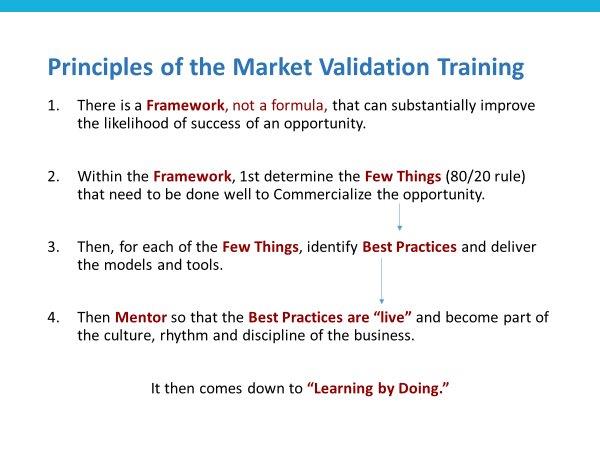
This slide clearly describes a management process, beginning with a framework, or template, applying Pareto’s Principle, developing best practices and then incorporating these in to the company culture.
If we view management as an art, as in “the art of getting things done through others”, then we may rely only on management skills and not on management processes. However, the world is not that black and white, as we see in the Program when we describe sales processes as distinct from sales skills. Decades ago, selling skills were considered very critical, but today they are much less critical. Today, effective sales management starts with sales process management, including sales funnels, Contact Relationship Management and other processes, critical for revenue generation and the success of the company. If we view management more as a science than an art, then processes are clearly and routinely incorporated. In the Program, we describe the science of customer discovery, where participants learn how to clearly and succinctly define their assumptions, or hypotheses, and then get out of the building to test them through structured conversations with prospective and actual customers. Based on these scientific tests, assumptions or hypotheses are either validated or modified, and then another round of testing occurs. Participants are very much encouraged to systematically follow the scientific method. Although many, or perhaps most, entrepreneurs would not describe themselves as professional managers, they often are professionals. This is especially true in the life sciences industry, where doctors, engineers, accountants and MBAs may well join together to co-found their start-up. These professionals are generally receptive to structured scientific approaches to manage their business – it just has never occurred to them to manage sales and marketing scientifically.
Alternatively, some entrepreneurs may have inherited a family business, or may launch their start-up with family members. This calls for a different management approach. For example, one cannot place corporate demands on a family business, since for example a no nepotism rule may be considered burdensome. Depending on the size of the business, often small to medium size businesses, but sometimes large corporations, the management approach may be paternalistic or professional. Or if the business has been around for a while and the family is so inclined, they may have hired professional managers, which in our opinion is often not a bad thing. Whatever the scenario may be, the Market Validation Program helps. It helps businesses, regardless of their origin, stage, industry, or ownership, manage its sales and marketing function more intelligently and thereby produce better sales results.
Levels of management also vary widely. Some organizations are essentially flat, as is the case with many small start-ups. Medium size companies, optimally with no more than about 200 people, need some sort of hierarchy, but in modern management theory, this is minimized. Perhaps one layer of workers, supervised in groups of ten, with managers based on line-of-business or functional responsibility, and then a chief executive officer. In other words, a four-layer organization with three levels of management – supervisory, managerial and executive. The effectiveness of such an organization, will in our opinion, turn on the management processes routinely deployed and the skills of the managers, individually and collectively. Simple processes may include daily or weekly stand-up meetings, monthly management reviews, quarterly planning sessions and annual reviews with budgeting. More complex processes may include management-by-objectives or comparable outcome or key success factor measurements, at the individual, team and company levels. In sales and marketing management, it needs to include a sales funnel process, a CRM updating protocol, and regular skill improvement standards. In life sciences, there must also be a Quality Management System. For example, medical device companies must meet ISO 13485:2016 and FDA QSR requirements.
Finally on management, companies need to step back and honestly look at where they are at in the evolution of management theory and application. We ask all participants to do this, to take stock of what they have done, what needs to be done, what they may have overlooked, what must be done urgently and what is important but can be done over the months, quarters and years to come. If management teams are not moving forward, then they are sliding backwards, because the world moves forward around them at a blistering pace.
Review
A management review process is a systematic way to check on outcomes relative to objectives and do course corrections as required. In the life sciences industry, companies must do this consistent with their Quality System Manual. For example, for compliance with ISO requirements:
“An important aspect of ISO Certification is the use of fact-based decision making which is the use of figures and evidence to evaluate the outcome of a proposed decision before implementing it. As a Management Review meeting involves making decisions about changes to and the direction of company policies and the Management System, examining appropriate evidence is vital to this process.
The evidence that should be brought to a Management Review includes:
• Minutes of previous Management Review meeting
• Management System documentation
• Internal and External Audit Reports
• Relevant records (including customer feedback, corrective action log etc.)
• Register of Legal and other requirements
• Complaints analysis
• Corrective and preventive actions and close-out of Management Information Reports
• Policies review”
In sales and marketing review processes, as outlined in the Program, this level of rigour is helpful but not mandatory. What we do expect is that each company’s sales and marketing executives have clear metrics that they track routinely – ideally each day. For example, how customer complaints are tracked and measured, to meet the Quality System requirements, but also as good management practice. Revenues need to be tracked, as do gross margins, and cost of sales needs to be tracked. The timelier these measures can be reported, the better, although this timeliness requirement shifts with the age and stage of the company. For example, there can be no revenue tracking in a pre-revenue company, but other key metrics, such as per cent design completion must be tracked. When revenue generation commences, tracking may be limited to the announcement of each new sale – its dollar value, gross margin, cost of sales, and length of sales cycles – all important parameters to feed in to the early-stage sales funnel. The sales funnel must be established as soon as prospects emerge and this must be managed through a simple CRM, like Insightly or HubSpot. The funnel and the CRM should be reviewed at least weekly, even in early stages of revenue generation. This is critical because these tools allow the company to develop a repeatable sales process, which is essential to creating sustainable, repeatable, profitable revenue – the cure all for any early-stage cash-strapped company.
Behavioural review is another management discipline that is implicit in the Program. We hold Program participants accountable for their deliverables at each workshop. Did they do their homework? Did they do their pre-work? Are they doing the in-class exercises? Are they actively and positively engaged in the Program? Are they on their way to success or failure? Are they achieving the requisite steps on their core deliverable – the Go-to-Market Plan? Do they listen when others are talking? Are they constructive in their criticisms of others in the workshop? Mentors and instructors are expected to lead by example.
In the context of the Program, we ask participants to continuously review their work with an eye to continuous improvement. If someone tells us that they drafted their positioning statement, reviewed it with a dozen customers through customer discovery, and made no changes to it because the original draft was perfect, then we are sceptical and we let them know this. We would much rather see that their review led to revision, further discovery and more revisions. Meaningful review requires an understanding of key metrics, critical success factors, a spirit of continuous improvement and regular updating of seminal documents, such as the positioning statement, value propositions and others.
“What you don’t measure you can’t manage” and the corollary is also true: “Don’t measure what you don’t intend to manage” and finally, “you must routinely review what you measure to improve how you manage your busines, especially your time-sensitive sales and marketing activities.”
Review can be either informal or formal. What is described above may be mostly considered informal. We also challenge our participants with more formal review, usually in a peer-review format, but also one-on-one. For example, at the start of most sessions we ask participants to pitch from memory or read from their script, their revised positioning statement, and other exercises they work on during the Program. We then invite feedback from the audience, which is intended to be substantive, such as “I like that because it is so much more specific than what you shared with us originally. Before you were talking about all 5,000 US acute care hospitals, now you have identified your sweet spot hospitals, those with about 350 beds that are considered tier two. And you have a bunch of good reasons why they are an easier target, although still challenging and time consuming.”
An example of one-on-one formal review is from an experience I had while still an MVP mentor. The client company was an early start-up with no revenue. They were working with the US Army on developing a walking aid that charged their batteries and reduced their kit weight. The prototype was probably at alpha stage, the company was bootstrap financed and received some R&D grant funding from both Canadian and US agencies, including the US Army. We had just finished reviewing the Technology Adoption Life Cycle Curve and I asked him again where his company was on the curve. He placed his X on the high rising part of the curve, where the early majority is close to becoming that late majority – in other words, in the third of six phases, which leads up to 50% capture of the market. This is the same spot on the curve he had occupied in class and the facilitator had suggested that he may want to think about this and revisit it with his mentors. An animated discussion followed and he was either unable or unwilling to revise his spot on the curve, even though any objective observer would see clearly and easily that he was at the origin, with no revenue, an alpha prototype and just one non-paying customer. He was not happy with our conclusion and this was sadly the last we saw of him. Many years later he retained me as a consultant on a medical application of the same technology, and he was still at the origin of his technology adoption life cycle curve. To this day, I cannot say what went wrong in this formal review and why he was unable to adjust his thinking to see that even though the US Army may be about 50% of his global market, having them pay some R & D expenses to test out a prototype does not constitute domination of the market. Also, worth noting is that this was a highly disruptive technology, with a huge chasm to cross to move from early adopters and innovators to the early majority. To cross this would take a lot of money, a lot of time, and a lot of marketing innovation, none of which they had, at least not sufficient to take them where they needed to go.
To sum up, the key elements of review in the context of the Appleton Greene process of planning, development, implementation, management and review; within the context of the Market Validation Program are intertwined in the workshop exercises, the accountability that each participant is held to by the mentors and the instructor(s), and the structure of the Program itself.
Over the years, certain agencies have made MVP available online and even in this format, it has built in review mechanisms. You simply cannot get through all the modules without properly completely each one. Each module can be considered a pre-requisite to the next module. For example, anyone who gets stuck drafting the value proposition for economic buyers has not properly completed their positioning statement and most go back to those exercises and redo their draft. This is a substantive process that will require them to speak with their colleagues, customers and other stakeholders. By structuring the Program in this way, the founders, mentors, instructors, professional educators and people like me that have worked on this for years to continually improve it, have made continuous review and improvement an integral part of the Program. Upon completion, participants will have met some foundational learning goals: they will understand market validation terminology, they will have completed a full first draft of their Go-to-Market Plan and reviewed that with their mentor(s), and they will be on their way to being the best new start-up in town, or the best emerging start-up division within their corporation. Although this may sound audacious, but years and even decades of plus 90% participant rankings and rave qualitative reviews support that this is an experiential Program that changes participants, their companies and their chances for rapid success through accelerated revenue outcomes.
Looking more broadly at the complete 24-module Program, which the first workshop reviews at a top-level, there is broad learning that occurs across all 24 major concepts. Furthermore, participants have the opportunity to apply this learning to their own situation, to improve business outcomes in their area of responsibility. With proper advance planning, organizational and project development, intelligent implementation and execution, effective management and comprehensive review processes, each participant has the opportunity to win in the marketplace like they never have before. In the words of one participant, “our return on investment was 1,000+%”. What more can we say?
Some other memorable quotes from those who invested their considerable time and modest dollar investment to participate: “…a wealth of first-hand experience in assessing new markets and describing a rigorous process for engaging customers to assess whether new product concepts fit deep customer needs.” “Participants learn about the essential practices involved in validating a market and a business model broken across 24 separate modules.”
“The program helped us make informed decisions on selecting our target audience and identifying the key pathways to market. We were incredibly lucky to participate in the MV program.”
“The Market Validation Program was essential to our early success to build a scalable company. It was engaging, informative, and provided a framework for entrepreneurs to identify/refine their go-to-market strategy. The Program also connected us to a group of peers and mentors that have continued to provide guidance and support. We were able to leverage the approach and contacts from the program to accelerate our customer acquisition.”
“In leveraging the momentum built from the Program, we have now grown our portfolio into a series of industry-leading products and reached well over $1 million in annual revenue, with distribution internationally in Asia Pac and the EU. The framework that he delivered remains an important component of our commercial expansion plan today, as we accelerate our growth into other international regions and across into industries outside medical. “
“As a mentor to start-up companies in the MVP with Mr. Christie as the Lead Facilitator, I had firsthand experience learning from his approach and seeing the start-up founders and CEO clients benefit tremendously from his delivery. The MVP is already jam-packed with best practices for building successful start-ups, but David brings it to life with highly engaging, relevant stories sharing his real-life examples of the numerous client companies that he has successfully advised and consulted.”
All of us at Appleton Greene look forward to adding your testimonials to our published roster attesting to the continuing success of the Market Validation Program. Thank you for your time and attention to this introduction to the Program, Mr. Christie, MVP Certified Learning Provider.
Executive Summary
Market Validation – History
The Market Validation Program (MVP) has been developed and updated over decades. It is intended for any company that needs to validate its go-to-market plan. The emphasis in MVP is learning by doing, drawing off numerous well-respected authors and utilizing well-proven management tools, including Steve Blank’s customer discovery process, Osterwalder & Pigneur’s Business Model Canvas generation and testing, Eric Ries’ Minimum Viable Product/Service, Geoffrey Moore’s market segmentation, positioning statement and value propositions, and others, for a total of 24 modules.
Although originally intended for startup information technology companies in the eighties, it has proven to be applicable to virtually any industry type at any stage, provided the participant has a genuine interest in revisiting their sales and marketing programs and dramatically increasing their revenues. Through personal experience, delivering the full 24-hour program to hundreds of companies across the continent, I have discovered that everyone can benefit substantially by applying the 24 core concepts to their business opportunity.
The payback for their time and money invested is incremental revenue. With the involvement of mentors, or consultants, who have relevant experience, the learning process is greatly enhanced. In summary, what I have learned over the past decade is that a business person pursuing an entrepreneurial opportunity, supported by an experienced mentor/consultant, using the tools provided in the Market Validation Program, will see the holes in their go-to-market approach, fill those holes by applying the MVP principles, and dramatically increase their revenue in short order.
Market Validation – Current Position
The Market Validation Program is designed to facilitate learning by doing, so that each company participant can apply the principles to enrich their business opportunity. Each module in The Program can be easily delivered in one six-hour session and the client then has one month to work on implementing the core concepts in their actual business setting, with the support of our world-class channel partner Accredited Consultants (ACs).
Therefore, the total elapsed calendar time for the full 24-module MVP will be 24 months. This is ideal and allows the client companies to learn, implement and experience each of the modules over the month between each module as instructed by the AC(s). The Program is intended to be industry agnostic and to be applicable regardless of the age and stage of the company. All that is required is that participants must bring a significant business opportunity to the Program and be willing to apply the principles to provide a fresh perspective on their opportunity. They need to believe they can dramatically improve revenues by working the Program. Although we cannot guarantee success, we can make a compelling argument for why the time and money spent on the Program should result in success. In the words of at least one participant: “My return on investment by participating in this Program is easily in excess of 1,000%.”
Market Validation – Future Outlook
Although MVP is applicable to virtually any business setting, it is also open to customization, with modules that can be added, subtracted or modified according to client requirements. The overall objective of MVP is to validate the client’s go-to-market plan and improve revenue by leveraging the knowledge and skills from the Program.
MVP has been proven in over a dozen North American geographic markets from coast to coast, with dozens of industry types, and with companies at pre-startup, start-up, “rev-up” (a dramatic revenue increase), market expansion, restart or other stages of company development in the market. The MVP concepts may be applied to new company startups or to division startups within an existing corporation.
It is conceivable that MVP may become industry specific. For example, the current vision is to offer a Life Sciences Program that will still be broadly applicable, as the industry itself is, but also somewhat tailored to some of its uniqueness, such as the heavy federal regulatory burden it carries.
Based on this natural evolution, we may then extend this to other industries, such as wireless, IoT, technology, environmental/clean-tech or whatever seems most relevant to our partner’s client base. Enhancing the program to provide industry specifics is not that difficult, since much of this turns on providing appropriate examples and having consultants to mentor or teach, who have the requisite industry experience.
Curriculum
Market Validation – Workshop 1
- Introduction overview
- Market type
- Positioning statement
- Market segmentation
- Positioning details
- Value propositions
- ROI
- MVP
- Opportunity size
- TALC
- Customer development
- Ideal customer
- Customer discovery
- Sales process
- Funnel filling
- Business model
- Company pitch
- BMC presentation
- BMC testing
- Goals plans
- Critical path
- OPP
- MV journey
- GTM plan
Distance Learning
Market Validation
As previously mentioned, the entire Program has been adapted for online delivery. There are essentially three core components – pre-work, in-class materials, and post-work. Each of these components is clearly described in word or PDF documents or Power Point presentations. The pre-work and post-work are described in word and PDF formats. The in-class materials include entire Power Point slide decks and worksheets in word or PDF formats. The presentation deck is not intended to be sent to participants, but with proper security controls it could be shared before and/or after each module via an Appleton Greene portal. All of these materials are complete, tested and ready to use, they just require Appleton Greene branding and some minor editing to bring them completely current and entirely relevant to the intended life science audience. For example, the first eight modules are supported by the following pre-work document, distributed prior to the day one workshop:
PRE-DAY ONE
THEME: DEFINING THE BUSINESS OPPORTUNITY
WORKBOOK
Open WORKBOOK folder and see Pre-Work for Day 1 Workshop.
This is the companion to the online module and contains necessary worksheets to complete the module.
RECOMMENDED READINGS
Open RECOMMENDED READINGS folder for files:
• 4 Steps to the Epiphany
• Crossing the Chasm
• Made to Stick
ADDITIONAL RESOURCES: START-UPS
Open ADDITIONAL RESOURCES START-UPS folder for video links:
• Why Accountants Don’t Run Start-Ups – Steven Blank
• Lean Startup Summary
ADDITIONAL RESOURCES: CUSTOMER DEVELOPMENT
Open ADDITIONAL RESOURCES CUSTOMER DEVELOPMENT folder for file:
• The Customer Development Methodology
To drill deeper in to this pre-work outline, this is the first 2 pages of the 12-page pre-work document:
Pre-work for Day 1 Workshop
In order to be ready to refine the thinking behind your product, marketing, sales and business, there are some things that you need to think about in advance of the first face-to-face workshop. The answers to the questions in this worksheet will be used during the workshop. It is important that you answer them before the workshop as there will not be any time during the workshop to do so. If you choose not to invest the effort required to carefully work through this material, you’ll quickly find yourself behind the rest of your colleagues.
Write a few lines about yourself and your company for your class introduction, including your role in the company, how long you have been there, what you hope to get out of this Program and something unusual about yourself.
Classify what type of company you are
Category: Sub-category
Cleantech Bioenergy
Digital Media Environmental
Hardware Apps (iOS, Android, etc.)
Life Sciences E-commerce
Software Content Publishing
Services Manufacturing
Telecom Semiconductor
Medical Devices
Pharma / Drugs / Genomics
Enterprise software
Consumer software
Design services
Software development services
Wireless
Don’t think you fit in any of them? Write down how you would categorize yourself.
For the recommended readings we provide a 45-page PDF summary for Blank’s Four Steps, a 4-page PDF of Heath’s Stick and a 21-page word summary of Moore’s Chasm.
We then provide the following video links (see the next page):
Finally, we provide a 76-page summary from Stanford University on Steve Blank’s Customer Development Methodology.
Comparable support documents are ready for the subsequent eight and final eight workshops, subject to review and approval from Appleton Greene as required.
Tutorial Support
Market Validation
The distance learning guide above also describes the tutorial support developed, as indicated in the following example for workshops 9 – 16.
PRE-DAY’s 9 – 16
THEME: CUSTOMER DEVELOPMENT
Key Activities: Discover and validate that you have identified the market for your product, built the right product that solves customer needs, tested the correct methods for acquiring and converting customers, and developed the right resources to scale the business. (Time: 1-2 hours)
WORKBOOK
Open WORKBOOK folder and see Pre-Work for Day 2 Workshop.
This is the companion to the online module and contains necessary worksheets to complete the module.
RESOURCES
This series of posts from the “Customer Development Manifesto” outline how the failures of the Product Development model for sales and marketing led to the Customer Development Model
RESOURCES folder for the following files:
• Steve Blank The Customer Development Manifesto_ Reasons for the Revolution (part 1)
• Steve Blank The Customer Development Manifesto_ Reasons for the Revolution (part 2)
• Steve Blank The Customer Development Manifesto_ The Startup Death Spiral (part 3)
• Steve Blank Customer Development Manifesto_ Market Type (part 4)
RECOMMENDED READINGS
RECOMMENDED READINGS folder for the following files:
• Getting Started on Customer Development
o The Achilles Heels of Customer Development
o 3 + (1) Ways to Request and Get a Face-to-Face Meeting
o Customer Development Funnel
• Finding People
o How to Find Early Adopters
• How to Conduct the Interviews
o The Fallacy of Customer Development
o The Art of Customer Development Conversation
As for workshops 1 – 8, the recommended readings and resource files are provided, and may be accessed either through an AG portal or through email distribution from AG, or both. The pre-work assignment entails the following:
Pre-work for Day 9 – 16 Workshops
You are now going to prepare for work around customer discovery and these worksheets will help guide you through the next steps of the critical path
Where are you on the TALC?
Innovators Early Market Chasm Bowling Alley Tornado Mainstreet Total Assimilation
State your Hypotheses
Product
What features, key benefits, your IP, dependencies, schedule, cost of adoption
Customer
Types of customers, their problems, organization, a day in the life of, ROI, MVP
Channel & Pricing
How will you sell & at what price?
Demand Creation
How you will create customer demand for your product?
Market Type
New, resegmented – low cost, resegmented – niche, existing
Competition
Likely competitors, how well entrenched, what you do different from competitors
Finally, the last eight workshops are supported through the following distance learning guide and tutorial support guide:
PRE-DAY 17 – 24
THEME: COMMUNICATION AND PLANNING
Key Activities: You’ll complete some offline activities that will help you enter the 3rd workshop day well-prepared. You will prepare to deliver your 5-minute pitch, assemble components of your business model canvas and assess your venture’s readiness to move forward. (Time: 1-2 hours)
WORKBOOK
Open WORKBOOK folder and see Pre-Work for Day 2 Workshop.
This is the companion to the online module and contains necessary worksheets to complete the module.
• Come with your script for your 5-minute pitch and prepare to present your pitch
• Bring the second version of your Go-to-Market Plan
• Bring your notes from customer discovery interviews
• Bring the completed pre-day 3 workbook
INVESTMENT PITCHES
Here are 4 investment pitches delivered by entrepreneurs in an accelerator program to a crowd of 700 people including investors from Canada and the US.
Open INVESTMENT PITCHES folder for video links:
• Fastgrab Pitch
• LISTN Pitch
• My Customer Pitch
• reelyActive Pitch
Final note to AGC – we also have these materials for “day of” and “post work”.
How To Study
Market Validation
There really is no magic in how to study for the Market Validation Program, provided that each participant has the proper motivation in participating. This is why we refer to them as participants and not attendees. We do recommend that each participant follow this tried and true process.
First, read the pre-work material, either the entire reference book or article, or the summaries provided.
Second, view the videos and make notes. Also, highlight the relevant sections of the reading summaries.
Third, complete the pre-class workbook and allow adequate time to do so. The time that is allocated should be during your peak mental performance periods. It is not enough to get all your important work done during your peak periods and then slide this in to a time when you are mentally depleted. Participants get out of the Market Validation Program what they put in to it. Just as we expect everyone to show up for the six hours of class time well rested and well prepared, we also expect them to put at least six quality hours in well in advance of each session, and to review these materials with their colleagues, mentors, consultants and others prior to each workshop. Remember that the course is written to a seventh-grade level, so if the participant has children at home who are seventh graders or higher, they can practice pitch to them and/or review their exercises with them. If the person lives on their own but has a pet, pitch to the pet or to themselves in the mirror or on video.
For all the pitches – personal pitch, positioning statement, five-minute company pitch, business model canvas pitch, one-page plan pitch and any others, practice makes perfect and this means practising until the pitch flows smoothly without reading it or steadily referencing cue cards or notes. Practise, practise, practise until you reach the point of diminishing returns. And get feedback from someone whenever possible. We know from countless five-minute pitch workshops that delivering the pitch to your peers, getting their feedback, re-delivering your pitch and getting their feedback again, results in surprising and dramatic improvements. Many if not most of our participants enjoy the constructive feedback so much that they want to deliver their five-minute pitch a third time with the entire groups of participants. Practice, with peer feedback, really does make perfect.
In closing, it is important to remember that MVP is not an academic Program. It is a learn-by-doing Program, so if there is one key to success, it is to Get Out of the Building, as Steve Blank so clearly asserts in his lessons about customer discovery. If participants are only talking to themselves and not to prospects or customers, then they will not meet the criteria necessary for success in the market place.
Preliminary Analysis
Market Validation
If I were preparing for my first Market Validation Program Workshop, I would look in the mirror and ask myself, why am I taking this Program? What’s in it for me? Why will my Company want me out of the office one day each month for 24 months at a cost of $xyz? What is the expected Return on Investment? If the answer is anything like this then they person should not attend:
“I just need a break from the office. Besides, I am entitled to attend. The Company thinks they know more than me about selling and now they think I need to attend this so-called Market Validation Program to learn something I don’t really know. I cannot imagine what I may learn, but as I say, this will be a nice change of scenery and maybe I will meet someone interesting.”
Fortunately, I am not aware of anyone with this negative attitude that would result in no meaningful knowledge transfer. Alternatively, if the person thinks the following, they should attend:
“Wow, what a great opportunity, a chance to step out with my colleagues, shed our conventional wisdom, look at our target markets in a new and different way, and potentially hit our revenue number out of the park. I know it will be a lot of work but I am all in. If the Company is willing to invest the money, the least I can do is commit my time, energy and 110% participation.”
In other words, it really comes down to attitude. The right attitude will prevail, given that any adult in a position of responsibility in their business has the ability to apply the simple concepts we cover. The caveat is that the concepts are simple but the application of them can be very challenging, which is where a skilled facilitator, mentor and CLP come in. I have coached very talented people through a one-on-one version of MVP, wrote their Go-to-Market Plan for them, then facilitated their participation in a group MVP, finally worked with them as a consultant to apply the core concepts, and it has still been a huge challenge that has taken them years to master. We also have co-facilitators and sponsors who have attended the Program countless number of times, in some cases a few times a year for more than a decade, and every time they complete another Program, they attest to the group that they were “blown away” by how much they learned. What more need we say.
Course Manuals
i) Process mapping: in the words of our esteemed Appleton Greene professor and advisor, Dr. Walters, process mapping is literally mapping your process, using a flow chart or otherwise illustrating your process in a snapshot, or otherwise mapping your process with the verbal equivalent of a flow chart. Our process is well mapped, oft repeated and validated as follows:
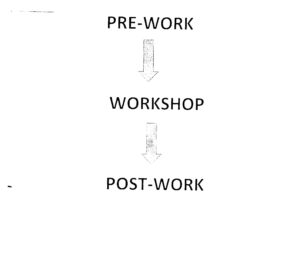
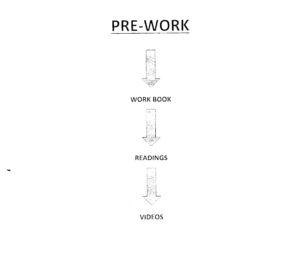
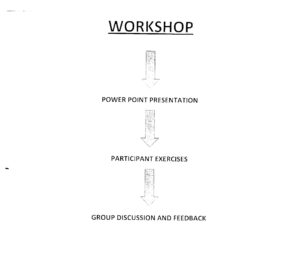
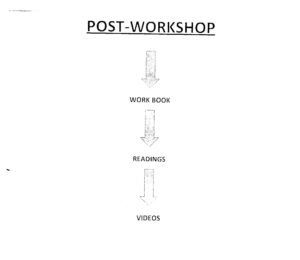
It really is as simple as this flow chart so nicely illustrates. Each pre-work breaks down further as follows:
WORK BOOK
READINGS
VIDEOS
Similarly, each workshop has three requisite process elements, as follows:
POWER POINT PRESENTATION
PARTICIPANT EXERCISES
GROUP DISCUSSION AND FEEDBACK
Finally, following each workshop, all participants are required to participate in the post-workshop process, as follows:
WORK BOOK
READINGS
VIDEOS
This completes the mapping of our pre, peri and post workshop processes.
ii) Process Mapping of Exercises: as illustrated in the preceding flow-charts. In summary, each workshop is preceded by a pre-work participant package that includes a work book, readings and videos. During each workshop, each concept concludes with an exercise or exercises, mostly individual but sometimes as a group. Following each exercise there is a group question, answer and discussion session. At the end of each workshop, participants are assigned home work, in a similar format to the pre-work: work book, readings and videos. They are expected to complete these assignments within two weeks of the workshop and review their completed assignments with their mentors, which may lead to rework. The remaining two weeks before the next workshop are allocated to the pre-work process.
One important final comment: there is an overarching process to all of the completed exercises, which is that once they are in final draft, they need to be inputted or cut and pasted in to the Market Validation Program format for their Go-to-Market Plan, which is the deliverable that they must properly complete by the end of the Program. We have four milestones for the GTM Plan – at the first workshop the Plan is introduced, the word template is provided and an example is circulated for participant review. At the 8-month workshop, the Plan is reviewed to illustrate that approximately one-third of it should now be completed and following the 8th workshop, each participant must review their progress with their mentor. This process is repeated at workshop 16 and again at the end of the Program, when the participants must present their final draft Go-to-Market Plan. We will need to determine what this looks like for one department and one company attending the Program – they may only have one shared document to present. In other manifestations of the Program, we have had many companies participate and many GTM Plans to review, which worked quite seamlessly by making this the primary responsibility of the mentor assigned to that company. Our Program processes are flexible and designed to accommodate most any situation, whether many company participants, many departmental participants, or many participants from a single department.
iii) Course manuals for process analysis: process analysis in the context of the Market Validation Program is an internal analysis of the participant’s department or company, at a high level initially, but ultimately going quite deep over the course of the entire Program. We ask these questions: what are you doing currently? What works? What does not work? What does market validation mean to you today? How do you think validation of your market happens in your company? When you completed the pre-work work book in advance of the first workshop, what did you learn about yourself, your department and/or company, and where you are in the process of market validation? Do you feel there is a lot for you to learn or just a little? Are we fine tuning or making a major course correction?
The manuals already described – work books, readings, videos, presentations and exercises, are all designed to facilitate process analysis and to help participants better understand their current situation. Later in the Program, we ask participants to complete a current situation assessment checklist and to describe in their own words where they have organizational deficiencies, or not. However, in the first workshop, we also cover this in the story behind the opportunity participants are currently exploring, why they are attending the Program, what they expect to get out of it, etc.
iv) Course exercises for process analysis: the pre-work work book for the first workshop specifically addresses a process analysis of the company and/or department. We anticipate that in large companies’ their may be multiple departments – sales, marketing, sales support, product engineering, and senior executives who attend. This may include front-line sales or customer service personnel, sales managers or directors, and sales or marketing executives at the vice-presidential level. In small start-ups we may only have the founders – perhaps the Chief Executive Officer, Chief Technology Officer and if they are there yet, a Chief Marketing Officer. In medium sized companies they may be somewhere in between.
v) Course manuals for process re-design: this is really the secret sauce of the Program, which is designed to slowly but surely re-design the participant’s company sales and marketing processes. The manual for this is all what has been set out in the flow charts. Each work book, each reading, each video, each presentation and each exercise helps to re-educate and enlighten participants with a new and better way to approach their go to market plans. What we have discovered over many years, scores of Programs, hundreds of participants and over a hundred companies from diverse industries, is that many if not most really do not yet know what they do not know about how to effectively get their product to market. Many of them are not even guessing – they just do not know. In start-ups, this is often due to a pre-occupation with patents, product design and development, and ignorance about sales and marketing. This manifests itself when you ask for their Gant Chart and they illustrate product launch, with all of the many milestones and accountabilities that lead up to this, but they have little or no defined milestones for the journey beyond launch. We get them to chart their time to operating cash flow profitability and all the milestones along that path, but it is not until the final one-third of the Program that we are able to get them there. With medium size companies who have been in revenue for perhaps a decade, with annual turnovers of $10 million or so, they do not know much if anything about their step-out opportunity. A great example of this is the established family business on the cold Canadian prairies who thinks they can just enter the US mid-west market and make ten times the money they do in their domestic market. Apparently, they have not heard about Buy America, or any of the other rhetoric, policies and barriers that make this step-out venture ten times more difficult than it may appear on the surface. Inevitability, by the end of the Program, they have abandoned this US market entry idea and instead developed a plan to double down in their domestic market and exploit the opportunity at home, which they are much better positioned to do.
vi) Course exercises for process re-design: perhaps it may be easiest and most effective here just to provide an illustrative example, as follows:
Pre-work for Day 1 Workshop
In order to be ready to refine the thinking behind your product, marketing, sales and business, there are some things that you need to think about in advance of the first face-to-face workshop. The answers to the questions in this worksheet will be used during the workshop. It is important that you answer them before the workshop as there will not be any time during the workshop to do so. If you choose not to do invest the effort required to carefully work through this material, you’ll quickly find yourself behind the rest of your colleagues.
Where did your idea come from?
Tell the history of your product. Use these and other techniques:
• Boil it down to a sentence, something catchy that would be a tagline on your website.
• Answer the question: why am I developing this product/business?
• If I was writing the story of my business 20 years later (or in my memoirs…)
• I’m being profiled in Entrepreneur magazine and the interviewer asks…where did it all start?
• We’re making a corporate training video to orient new employees to the history of the company.
Check off the attributes that best describe the problem that your product solves.
* Real problem
* Focused problem
* Big problem
* Difficult problem
* Obvious problem
* Complete problem
* Worsening problem
* A problem that the customer cares about
What evidence do you have to prove that what you checked off is fact and not just your opinion?
What will your customers do with your product?
Day in the life of your customer
Look at the diagram below and imagine that you are the user of your new product/service.
Use either the image on the next page (and differentiate current from future) or the comparison grid on the following page to capture your thoughts on these concepts.
What is your market type?
When you completed the online module, you discovered that there were 3 options and each of these needed a slightly different approach. Choose the model that best suited your market type and make some notes on
Compare product, for existing market Identify where you will take customers from in a re-segmented market, focus on differentiator Identify what segments your customers could be grouped into.
List your top 3 competitors
1.
2.
3.
What are the key reasons customers (will) buy your product/service instead of competitive products/services?
List the top 3 things customers like most about your product.
1.
2.
3.
vi) Course manuals for process resources: we challenge participants to really think about the many ways they are actually resource constrained. We provide a simple three-way trade-off between time, money and other resources – people, tooling, equipment, bricks and mortar, etc. In the life sciences industry, these constraints can be enormous, since even simple Class 2 medical devices today typically take 3- 6 years and $10+ million to take from idea to commercialization stage. For start-ups, the message that they should expect at least 18-24 months and more than one million dollars, even for a simple, safe Class 1 medical device that meets an unmet clinical need, is daunting to say the least. So, we work with our participants and get them to prioritize – what absolutely must get done in the next 30 days or the next quarter or the wheels will fall off your business? What resources are required, in terms of people, time and money?
Do you have those resources and if not, then how will you get them?
We provide real life examples and illustrate them to prove our point. Once everyone gets the concepts, we move on to the exercises.
vii) Course exercises for process resources: we have in-class exercises that are complimented with pre-work and post-work in the relevant work books. It seems that this is not the place to cut and paste all the course exercises, but they are available upon request. Program time management is an example and a microcosm of how each participant handles their overall time management. If they don’t have time to complete their pre-work and post-work then how much time do they have for their real job? If they don’t use their time in class effectively to complete their exercises, then how time efficient are they at attending to any task? We help draw any observed deficiencies out in class, in a respectful and supportive manner, to help them improve their time management skills.
viii) Course manuals for process communications: communications are a major theme throughout the Program. We focus on formal oral communication or what we loosely call “pitching”, informal oral communications in-class when asking participants questions or providing feedback, informal written communications with the exercises, formal written communications with the Go-to-Market Plan, and in the body, facial and verbal communications one-on-one with mentors. We emphasize that leadership is really all about how we communicate, including how you share your vision with stakeholders. In a nutshell, a great vision poorly communicated is close to worthless, and inversely, an absurd and useless vision well communicated may be worth something, perhaps even a lot. We illustrate this in the fun pitch, where participants take a meaningless grab-bag object and build a wildly compelling pitch around it. It is instructive and amusing that most participants will excel on this assignment in a way that they are at least initially unable to with the pitch on their own company. To sum up, we use every opportunity to reinforce our messaging about the importance of effective communications, lead by example illustrating this throughout, and call upon all participants to do their best, while continually improving. We have turned down many assignments because they are not clearly communicated.
ix) Course exercises for process communications: we have described this in the section viii) above and can provide samples of the actual exercises upon request.
x) Course manuals for process review: The Program is designed to continually review processes and to check in informally and formally on the progress each participant is making in applying the Program principles. We have Time 0, 8-week, 16-week and 24-week formal review processes. We also follow-up four weeks following the final workshop to determine where participants are at relative to their Go-to-Market Plan. Further, we invite feedback verbally in the workshops and in writing at the end of each workshop, using a standard feedback form, consolidate those results and act on any constructive criticisms.
xi) Course exercises for process review: the whole program is designed to be continually reviewed through both formal and informal process review mechanisms, as described above. There are exercises throughout that address this. Additionally, because we end each workshop with open feedback from our entire audience – participants, mentors and anyone else who chooses to participate – everyone hears what people got out of the day, in a positive and constructive way. Any constructive criticisms and rankings of each module, are covered by each participant and mentor in the formal feedback form, which is a daily discipline and exercise to ensure continuous Program improvement.
Project Studies
Project Study (Part 1) – Process Mapping
i) Process Mapping Course Manual:
How to prep mentors and attendees:
All attendees should go through all the pre-day work and post-day work.
Mentors should meet with their companies:
• Ideally before Day 1 of the training course
• After they complete each day’s homework (so about midway between course dates) to make sure they understand the work and are on track
• Prior to the next course date to make sure they are prepared and on track
• After they complete the last day’s homework
• They should also be given a list of the companies and a short blurb on what they do to help them prepare
1) Prior to Market Validation Training
Always send an email to all the participants (companies and mentors) to make sure they have all 24 days of the training blocked off. This should be done as soon as the dates are set and you know who your attendees are.
Each day is from 9:00 AM – 4:00PM with a one-hour lunch break and two 15-minute breaks
Plus, any other course info, you need to include for your attendees. Meals, parking, Zoom, etc.
2) At least 2 weeks prior to Day 1
You’ll want to send an email reminding all attendees of where and when Day 1 is.
For prep work, you’ll want to send them the following files:
• In the Day 1 folder, you’ll want to open the Pre-Day 1 folder
• For all attendees, they’ll get everything in the ALL ATTENDEES folder – let them know that they should read the file OPEN THIS
FIRST. The supporting documents/materials mentioned in this file are in the other folders.
• Mentors should receive the FOR MENTORS ONLY folder files as this document helps them with their roles and responsibilities as a mentor for this course as well as a bit more of an overview on what this course and specifically Day 1 includes. (note that these documents are from ACETECH so the course timelines may not match exactly since we’ve made course updates through the years, though I think it is still beneficial for the mentors to go through these materials)
• The optional file does not need to be sent out but it would be good to include in your email to all attendees that they will be asked to introduce themselves, who they are, what they do etc.
3) Immediately after Day 1
Send an email reminding them to work on Day 1 homework and then onto prepping for Day 2 also to set up a meeting with their mentor once they’ve completed the homework
For homework, you’ll want to send them the following files:
• In the Day 1 folder, you’ll want to open the Post-Day 1 folder
• For all attendees, they’ll get everything in the ALL ATTENDEES folder – let them know that they should read the file OPEN THIS FIRST. The supporting documents/materials mentioned in this file are in the other folders.
• Mentors should receive the FOR MENTORS ONLY folder files as this is an agenda/checklist for how they can run their Post Day 1 meeting
For prep work, you’ll want to send them following files:
• In the Day 2 folder, you’ll want to open the Pre-Day 2 folder
• For all attendees, they’ll get everything in the ALL ATTENDEES folder – let them know that they should read the file OPEN THIS
FIRST. The supporting documents/materials mentioned in this file are in the other folders.
• Mentors should receive the FOR MENTORS ONLY folder files to help them prepare themselves and their companies for Day 2. (note that these documents are from ACETECH so the course timelines may not match exactly since we’ve made course updates through the years, though I think it is still beneficial for the mentors to go through these materials)
Also include this in the email:
We will start and end Day 2 with pitches: the “17 second positioning statement” first thing to start the day and a non-business 5-minute pitch to end the day. Remember what good looks like for the Positioning Statement pitches: 1) deliver it with passion and everyone can hear you clearly; 2) it only takes you about 17-30 seconds; 3) it’s memorable… and you don’t use notes – but this takes practice.
4) Midway between Day 1 and Day 2
Send an email and remind attendees:
• Day 2 date, time and location – note that Day 2 is longer.
• Remind attendees that they should have/are currently completing their Post-Day 1 homework and to set up their mentor meeting.
• Remind them to start working on preparing for Day 2 and ideally should set up 1 more meeting with their mentor prior to Day 2.
5) Right before Day 2
Send an email to remind them about Day 2 date, time and location and any other info.
Remind them to bring their MVP binders – you will be providing them with Day 2 slides and exercises to add to the binders.
6) Immediately after Day 2
Send an email reminding them to work on Day 2 homework and then onto prepping for Day 3 also to set up a meeting with their mentor once they’ve completed the homework
For homework, you’ll want to send them the following files:
• In the Day 2 folder, you’ll want to open the Post-Day 2 folder
• For all attendees, they’ll get everything in the ALL ATTENDEES folder – let them know that they should read the file OPEN THIS
FIRST. The supporting documents/materials mentioned in this file are in the other folders.
• Mentors should receive the FOR MENTORS ONLY folder files as this is a checklist for how they can run their Post Day 2 meeting
For prep work, you’ll want to send them following files:
• In the Day 3 folder, you’ll want to open the Pre-Day 3 folder
• For all attendees, they’ll get everything in the ALL ATTENDEES folder – let them know that they should read the file OPEN THIS FIRST. The supporting documents/materials mentioned in this file are in the other folders.
• Mentors should receive the FOR MENTORS ONLY folder files to help them prepare themselves and their companies for Day 3. (note that these documents are from ACETECH so the course timelines may not match exactly since we’ve made course updates through the years, although it is still beneficial for the mentors to go through these materials)
7) Midway between Day 2 and Day 3
Send an email and remind attendees:
• Day 3 date, time and location
• Remind attendees that they should have/are currently completing their Post-Day 2 homework and to set up their mentor meeting.
• Remind them to start working on preparing for Day 3 and ideally should set up 1 more meeting with their mentor prior to Day 3.
Also include this in the email:
Now that you’ve seen what a 5-minute pitch looks like, now is the time to do one for your own company! We will start Day 3 working on 5- minute pitches on your own Startup!
8) Right before Day 3
Send an email to remind them about Day 3 date, time and location and any other info.
Remind them to bring their MVP binders – you will be providing them with Day 2 slides and exercises to add to the binders.
9) Immediately after Day 3 – Wrap Up
Send an email reminding them to work on Day 3 homework to set up a meeting with their mentor once they’ve completed the homework
For homework, you’ll want to send them the following files:
• In the Day 3 folder, you’ll want to open the Post-Day 3 folder
• For all attendees, they’ll get everything in the ALL ATTENDEES folder – let them know that they should read the file OPEN THIS FIRST. The supporting documents/materials mentioned in this file are in the other folders.
• Remind them to look at the templates and resources such as the strategic plan template and the blank business model canvas and the guide to the business model canvas etc.
• Mentors should receive the FOR MENTORS ONLY folder files as this is a checklist for how they can run their Post Day 3 meeting
Although most attendees take their large, filled out business model canvas home with them, the workshop administrator should always take a photo of each business model canvas and send each participant a separate email with the photo.
Note that the references to Days 1, 2 and 3 are representative of what we will do over days 1 – 24, with modifications as appropriate to reflect the expanded time line.
This section completes the Process Mapping of the Course Manual, consistent with the flow chart provided earlier in this document.
2. Process Analysis Course Manual: the analysis of the client’s current business process is mostly completed through the work books and exercises, some of which have already been shared. In addition to what has been shared, here is some additional representative material:
Exercise #4 – Self Assessment – Where am I now? What do I know?
In the event that you do not have your pre-work worksheet with you, use the templates on these two sheets to assess your current situation.
Where am I in the TALC
Innovators Early Market Chasm Bowling Alley Tornado Main Street Assimilation
Milestones completed in the Customer Development Model
Completed Enterprise Milestones
Completed Digital Media Milestones
Company Status
Me as CEO
Over the next 6 months
What critical things, if they didn’t get done, would stop me from achieving my goals?
•
•
•
•
Exercise #5 – 6 Month Goals
Identify your key objectives for the next 6 months and rank these from most important to least important. The Top 1 goal is the one thing that *must* be accomplished.
Priority
Exercise #6 – Top 3 Goals and Milestones
Transfer your top 3 Goals from the previous template and identify 3 Milestones for each Goal
Start Date: _________________________ End Date: _________________________
MILESTONE
MILESTONE
MILESTONE
GOAL #1 – Top 1 of 3
MILESTONE
MILESTONE
MILESTONE
GOAL #2
MILESTONE
MILESTONE
MILESTONE
GOAL #3
iii) Process Re-design Course Manual: the elements of process re-design are woven in to the fabric of the Program in many different areas, including pre-work and post-work work books, readings and videos; workshop slides and in-class exercises, and in the examples provided by the facilitator. Perhaps the best example of this is the Business Model Canvas.
Participants participate in a group exercise whereby each building block is explained, with an example provided, in the requisite order and then each participant completes that building block. In about one hour, the entire Canvas has been created for each participant, on an over-sized wall chart.
Then the participants are invited to challenge their assumptions and see how many of these are purely fictional or hypothetical and how many, if any, are entirely factual. They then assign an appropriate probability percentage where the higher the percentage, the more likely the block is factual.
Finally, each participant is invited to present to their colleagues, who challenge their assumptions and conclude individually and collectively that it looks like the business is properly organized and, in all likelihood, will make money or not.
Optionally, with time allowing and participant interest, there is a module that is well described in Osterwalder and Pigneur’s reference book – Business Model Generation. This module is an objective, quantified strengths, weaknesses, opportunities and threats, or SWOT, analysis. The endpoint of this analytical process is a clear action plan about who needs to do what when.
4. Process Resources Course Manual: we check in routinely with all participants to determine if they have adequate resources or not. For example, if the CEO of a start-up claims they will achieve their first million dollars in revenue in their current year, which they are already half-way through with the first order not yet closed, the obvious question is how will you make this happen? If they do not have a sales person and cannot make the sales themselves, then do they have the money to make the hire? If not, then are they fund raising? If not, then what are they doing? It will take time, money and talent to close their first sales and to realize revenue. Time is running out, there is no money available for this, and they do not yet have the talent. These process checkpoints are implicitly buried in the Program materials, known to us as the Program CLP and should be explicit to a properly trained facilitator.
One important caveat is in order – we do not teach, facilitate or coach participants on how to raise money. If they are start-up stage and need investor money, they need to learn about this elsewhere. The focus of the Market Validation Program is all on how to make money through the acquisition of profitable customers, and turning this acquisition in to a profitable repeatable “flywheel” process.
5. Process Communications Course Manual: as discussed previously, the Program is rich in content intended to help participants with written and oral, formal and informal, communications. We emphasize the importance of communications in every work shop, it is clearly focused on in the work books, many of the exercises and in many of concepts that are facilitated and practised. Much of the focus is on how to express your self, but there is also an extensive module on how to listen effectively, how to discover customers, and learn from them about what you must to do to uniquely fulfill their needs.
vi). Process Review and Key Performance Indicator: if there is only one KPI, then it is without a doubt the change in top-line, or gross, revenue. We also expect net revenue, gross margin and operating profit to all increase, but the topline increase drives these others. In the pre-work for day 1, all companies are asked to disclose their current revenues and number of accounts. We ask them to share any sales success stories during their 24-month journey. At the end of the Program, we ask them what their revenue is and their number of accounts. Most companies report an increase, unless they are just not yet ready for revenue generation. The process review that feeds this KPI includes the sales funnel. For example, how many layers are there in their funnel? What are the exit criteria to move from one layer to the next? How much time does it take to move from above the top of the funnel to beyond the bottom? What is the probability of advancing at each stage? What is the total sales cycle time and what are the associated costs? The “bottom line” here is the KPI top line – gross revenue.
Workshop Benefits
Marketing
- Increase revenues
- Decrease costs
- Improve profitability
- Optimize DMS
- Better planning
- Optimal deployment
- Support sales
- SMART goals
- Department Coordination
- Happier customers
Management
- Stronger leadership
- Greater profitability
- Accelerated growth
- Better deployment
- Executive enhancement
- Reduce risk
- Faster cycles
- Bigger revenues
- Reduced OpEx
- Improved image
Human Resources
- Happier salespeople
- Improved productivity
- Greater sales
- Better coordination
- Close ratios
- Cycle times
- Enhanced margins
- Recruit talent
- Tremendous training
- Lower turnover
Client Telephone Conference (CTC)
If you have any questions or if you would like to arrange a Client Telephone Conference (CTC) to discuss this particular Unique Program Proposition (UPP) in more detail, please CLICK HERE.
























